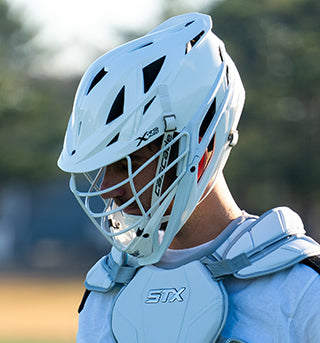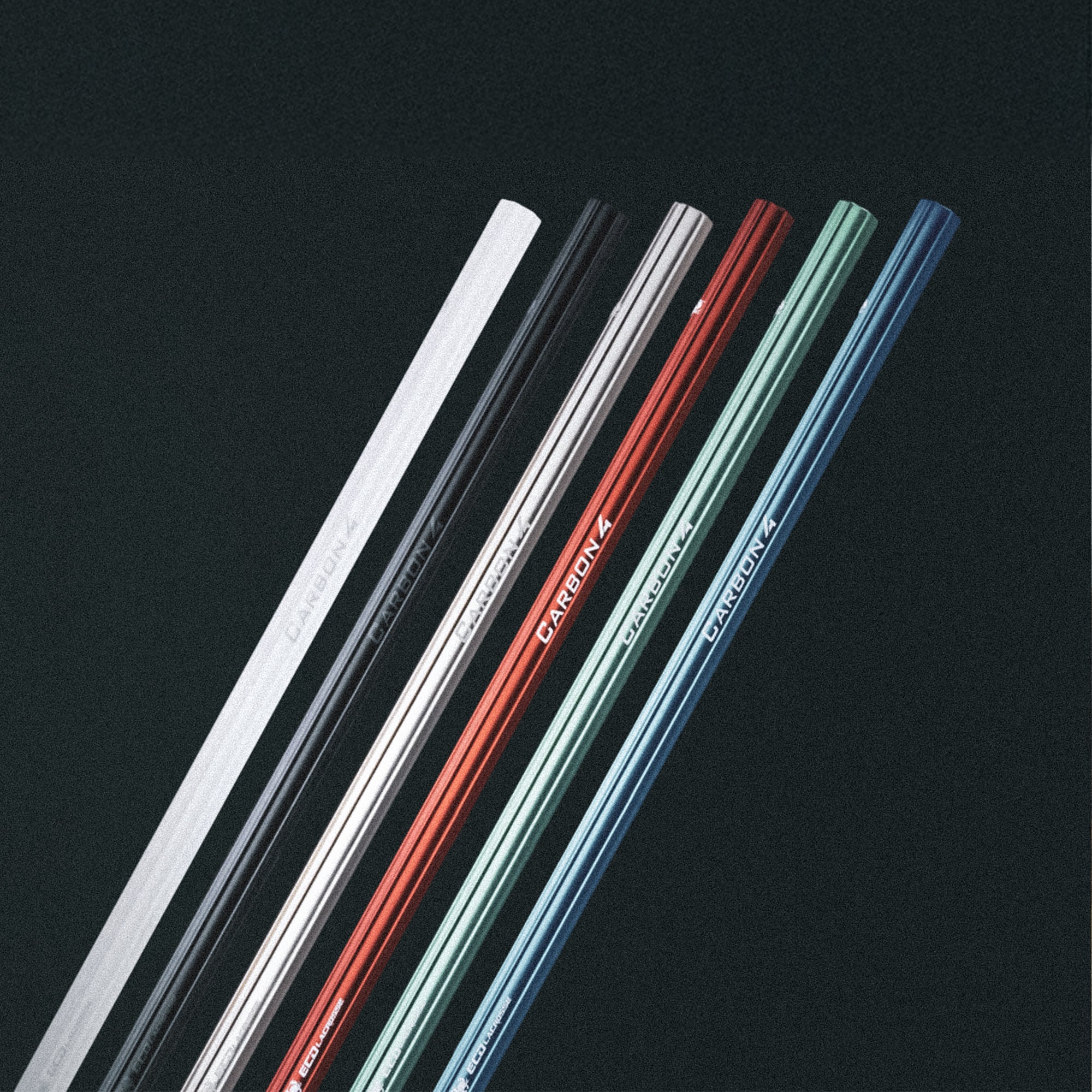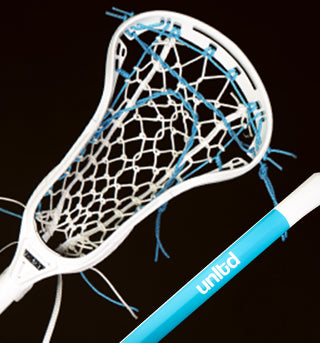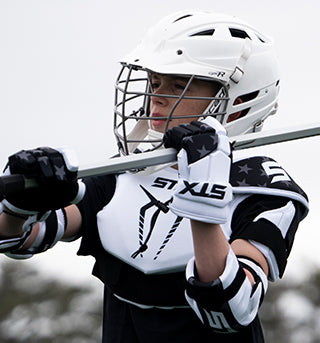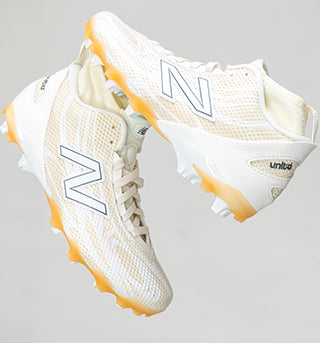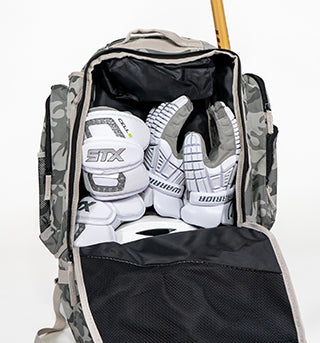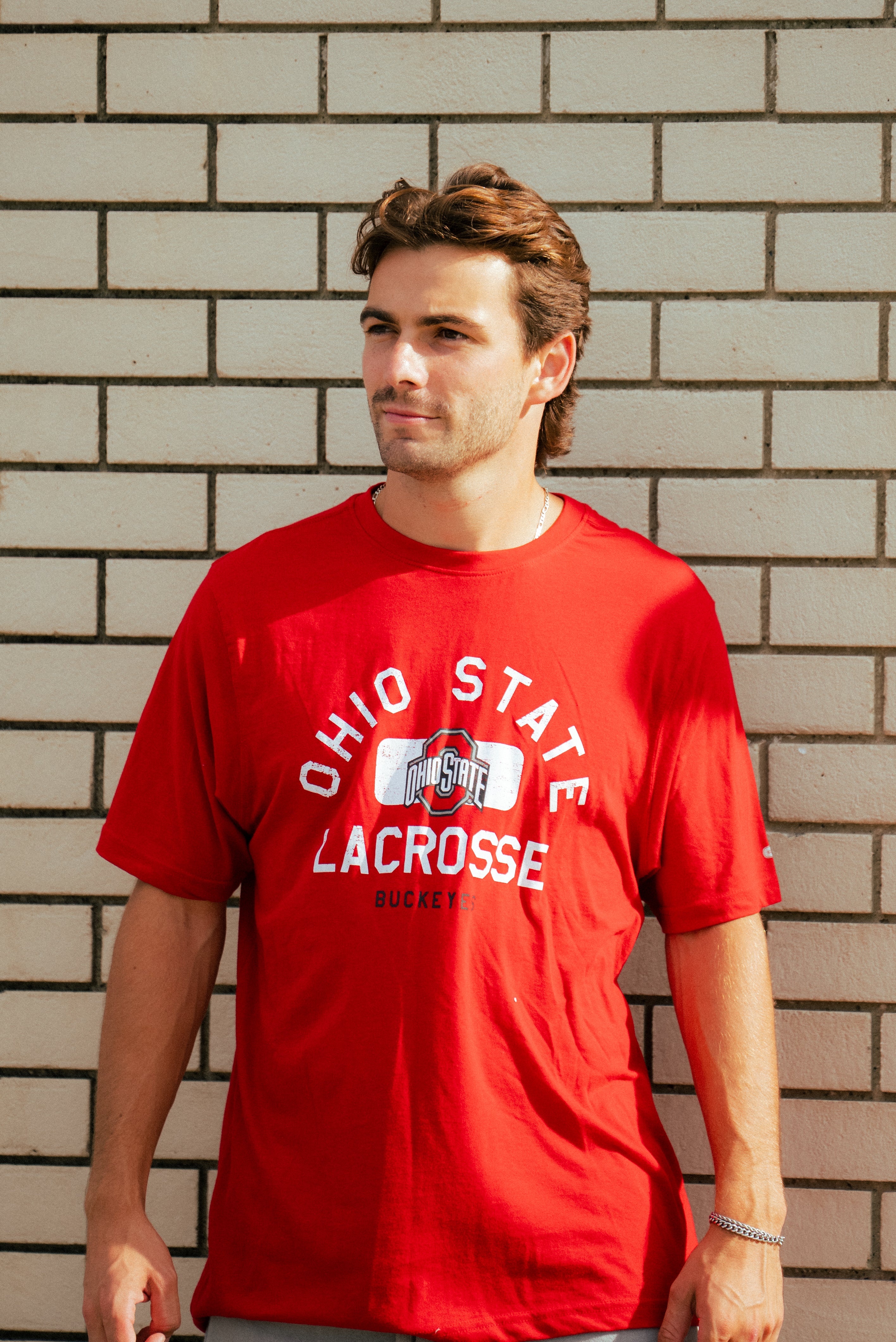One player can’t do it all. You need your offense to come together and play as a complete offense. You want to avoid a never-ending free-lance offense where each player is doing whatever they want, whenever they want. You need coherence; you need plays. Before you can get to that, you have to understand the advantages and disadvantages of each offensive set, this way you can determine what works best for your personnel, and start to build plays to accentuate their abilities.
1-4-1

The 1-4-1 offense is set up like the above diagram: 1 middie up top, 4 players across the middle above the crease, and 1 attackman playing “x” below the goal. This formation works best for teams that have an elite dodging middie and an elite dodging attackman. The dodging middie will be the one who stays up top around the restraining line, and the dodging attackman will be below the goal at X.
The point of this formation is to allow the dodgers free range when dodging. Think about it, no one likes to be crowded when trying to make a move. However, if your dodgers can win their matchups, the advantage you gain happens in front of the net. Stacking 2 middies and 2 attackmen in front of the net makes the defense’s slide package more difficult. This formation not only increases the distance a defender must slide, but it also makes dodges more unpredictable, causing miscommunications between defenders on who is the 1 slide, 2 slide and so on.
Stacking so close to the crease also allows for more effective off-ball movement and picks – but this means your offense can’t get lazy. Opportunities and feeds will only come if these 4 middies and attackmen are mobile, otherwise the dodging middie or attackman really won’t have any feasible outlet if the dodge is ineffective.
Which sort of brings us to the disadvantages that come with the 1-4-1. Firstly, as we stated earlier, this set is designed for a team that has an elite dodger at the top of the field and behind the goal. If these players cannot consistently win their matchups, the offense will be stagnant, and there will most likely be a bunch of turnovers. Having most of the players stacked inside depletes outlet options for the dodgers when they fail to beat their defender 1-on-1, which can lead to long or forced low-percentage passes, and ultimately turnovers. At the top of the field it is especially important to win the 1-on-1, because you are one good check away from losing the ball into a fast break going the other way.
This formation can also prevent outside shots, which obviously doesn’t work for teams with top tier shooters. The number of bodies in front of the goal can sometimes clog the area up and cause shots to be blocked, deflected, or even intercepted.
We would recommend jumping in and out of this set throughout the game to keep the defense on their toes rather than a permanent go-to formation. Occasionally slipping into a different set keeps your scheme from becoming stale and repetitive, and the 1-4-1 is a perfect wrench to throw at a defense that can help you rattle off a few goals before they figure it out.
2-2-2

As shown above, the 2-2-2 is 2 middies up top, a middie and an attackman stacked in front of the net, and two attackmen behind the net. We would recommend this formation for more novice teams, because it requires less complete involvement from all 6 offensive players, and can allow for plays involving 2-3 players at a time.
The advantage of the 2-2-2 is the simplification of your playbook. This formation is most effective when running 2-man picks and re-picks. For this reason it is the most effective offense for young players, because it can be harder for them to understand a system that involves all 6 players at once. This formation can also mask an overall talent disparity within the offense by allowing plays to run through a few key players. Let’s face it, not every program can be full of D1 recruits, and if you are lacking a capable 6 player offense, the 2-2-2 can be a good solution.
The shortfalls of this system stem from a lack of complexity and outlets. It is not only hard to run any in depth plays due to the positioning of each player, but when a play/dodge fails, the player will most likely have to force a long pass for an outlet. Similar to the 1-4-1, this formation can also clog the front of the net, preventing outside shots from reaching the goal, and also hindering your dodgers’ ability to get to the net without running into a defender.
As we said earlier, this is a great system to use for a beginner program, or a program without much depth. This can also be thrown into the mix on occasion in more advanced programs to run some hidden ball tricks or the occasional pick play. But again, we would not recommend this as a sole offensive set for an entire game.
2-3-1

The 2-3-1 offense is probably the most commonly used set. This formation is set with 2 attackmen behind the net, 2 middies out wide around the crease area with a crease attackman in the center, and a top middie. The 2-3-1 formation is utilized as a versatile offense with a lot of opportunity for ball rotation, dodging, and set plays.
The advantage to using the 2-3-1 is the balance it brings. You have a lot of room for middies and attackmen to dodge, but also still have readily available outlets if the dodging middie/attackman does not win their 1-on-1 matchup, so you won’t get stagnant against a good defense. This formation also gives you a lot of room to spin the ball before dodge, which keeps the defense constantly moving, unsettled and fatigued. This makes dodges more effective, and can also keep the slide package constantly changing against some defensive schemes.
Another advantage is the ability to invert middies to an attack position. This will drag a short stick defender below the net, into an area they are not used to defending, and clears the long sticks out of the crease area, opening up more shooting and passing lanes.
There is no perfect system though, and since this is such a universal set, most defenses are familiar with this type of offense since they have seen it so many times in practice. There are also a lot of moving parts and rotating replacements, and if one player does not follow through on their replacement duties, the whole structure can fall apart, leading to a loss of possession. For example, if the wing attackman does not rotate to X after the X attackman dodges, you can easily lose possession on a missed shot.
This is one of the most sustainable offenses throughout the majority of a game, but it requires a lot of communication and cooperation between teammates. The offensive talent should also be fairly balanced, having each player be at least somewhat advanced at all offensive skills. If your team can master the 2-3-1, the possibilities with plays are endless.
1-3-2

This offense operates similar to that of the 2-3-1, with some minor differences. The formation sends an extra middie to the top, and pulls one of the attackmen up into the center, outside of the crease area, as shown in the above diagram. This is another dynamic offense that allows for a lot of offensive development and plays.
The pros you’ll find in the 1-3-2 is the creation of outside shooting threats without the use of a dodge or cut. This requires the defense to stretch out and apply more outside pressure, opening up the middle of the field for cuts, feeds and off-ball picks. There are also outlets readily available for any dodging middie or attackman to make the easy pass if they are unsuccessful in their 1-on-1 matchup. The 1-3-2 formation is a great way to retain ball possession for an extended period of time, and can allow your offense to patiently work into plays, or wait for skip passes to open up and create higher percentage shots.
There is even more risk with losing possession on a shot in the 1-3-2 than there is in the 2-3-1. Being that there is only one attackman at X at a given time, if they are the dodging player, there is virtually no back up on the shot unless the backside player rotates down. Also, due to the similarity to the 2-3-1, defenses are generally comfortable with facing this set, and a lot of their slide packages will work well against it.
This is an offense that can sustain through the entirety of a game if need be. We would recommend this offense for a roster with stellar shooting threats, and it is most effective when partnered with the 2-3-1. These sets can easily be rotated in and out of, and jumping back and forth between them can help confuse a defense.
These are your standard offensive sets. There are more, such as the 3-3 and open set, but these are less common. Overall, you want your offense to become comfortable in multiple sets. The more dynamic your offense is, the more threatening you will be to the opposing defense. So hit the books, be aware of your personnel, as well as your opponents personnel, and work on your formations and transitions in practice so it can translate to the game.


